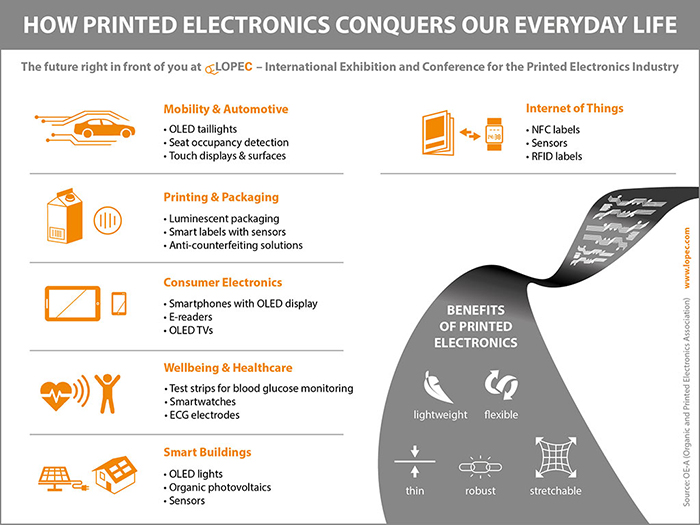Celebrating the last ten years of printed electronics
In the build-up to the tenth annual LOPEC event, taking place in Munich in March Hans-Jürgen Lemp (Director Global Sales & Business Development New Platforms, Merck KGaA), Thomas Kolbusch (Vice President, Coatema Coating Machinery) and Dr. Wolfgang Clemens (Head of Product Management, PolyIC & Co. KG) talk about a decade of printed electronics and the markets of tomorrow.
Mr. Kolbusch and Mr. Clemens, you presented your companies at the first LOPEC in 2009. Do you still remember it?
Kolbusch: “Yes, very well in fact. The first LOPEC took place in Frankfurt - it was much smaller than it is now in Munich.”
Clemens: “And much more technical. In the early days, the event focused on science and technological developments. Nowadays, we exhibit more and more products that you can buy.”
Progress in printed electronics depends on new materials. What has happened over the past decade?
Lemp: “With organic electronics, the area that we are concerned with, you do not only need materials expertise but also an in-depth understanding of how individual printed layers interact and how they can be optimally matched to each other. The mobility of electrons is important, otherwise electricity cannot flow. In recent years, we have significantly increased this mobility. This is important, because the more mobile electrons are, the more applications are possible.”
Kolbusch: “Organic photovoltaics is a good example. Initially, the solvents in the printing materials were problematic and you had to work in a nitrogen atmosphere. Now there are stable systems with safer solvents that are suitable for large scale production.”
Clemens: “We are not against organic conductors but our basic material is silver. We can now print tracks on polyester film so finely that you cannot see them with the naked eye. Such transparent, conductive films are, for example, suitable for displays with a touch function. This remains a major market.”
Kolbusch: “Hybrid systems which combine printed and conventional electronics are also an interesting prospect. One example is the integration of silicon components into the printing process, i.e. the placing of chips while the production line is running.”
Printed electronics has developed very quickly. To what extent has LOPEC changed over the years?
Kolbusch: “I still remember trade fairs where we were the only mechanical engineering company. The printing systems are now much more advanced and this plays a key role in market success. Anyone who would like to turn an idea into reality will find a suitable system.”
Clemens: “We have noticed that more and more sectors are showing an interest. Large companies, especially those from the automotive or consumer industry, send their technology scouts to LOPEC. They look at what technologies they can use in product development rather than research.”
Lemp: “LOPEC was always an ideal platform for us. More and more of the latest prototypes are shown here. This attracts large numbers of visitors who are looking for smart solutions. At LOPEC, we can present such innovations and discuss possible applications.”

Where is the greatest potential for printed electronics at the moment, in your opinion?
Clemens: “A great deal is going on in the automotive industry. There are still a lot of buttons and knobs inside a car, but these will disappear. The older generation might like to press a button but our children already prefer touch displays. We are seeing big changes everywhere - this includes household appliances and consumer electronics.”
Kolbusch: “As far as sensors for medicine, sportswear and other wearables are concerned, we are also seeing a breakthrough because we have solutions that you can put in the laundry.”
Lemp: “The adaptability of printed electronics is making entirely new applications possible. Take the Internet of Things (IoT) - how do objects and devices communicate with each other? What material properties do I need for this? Things that already exist today are becoming smarter, more interactive and more communicative. Printed electronics is helping to make visions reality.”
What role does LOPEC play in realising future trends?
Kolbusch: “For us, it is important to get involved with new sectors and maintain contact with our existing customers. At LOPEC, you can see new projects and talk about them. Our systems can be found in research institutions - we see them too at LOPEC because they are involved in the Scientific Conference.”
Clemens: “For us, LOPEC is the trade fair where we can show an international audience what sensor systems are capable of. We are open to all sectors and believe that now is the right time.”
Lemp: “We see ourselves as more than just material developers. We offer solutions which allow entirely new possibilities. For us, LOPEC is a stage, a place for inspiration, where inventors and users meet.”










